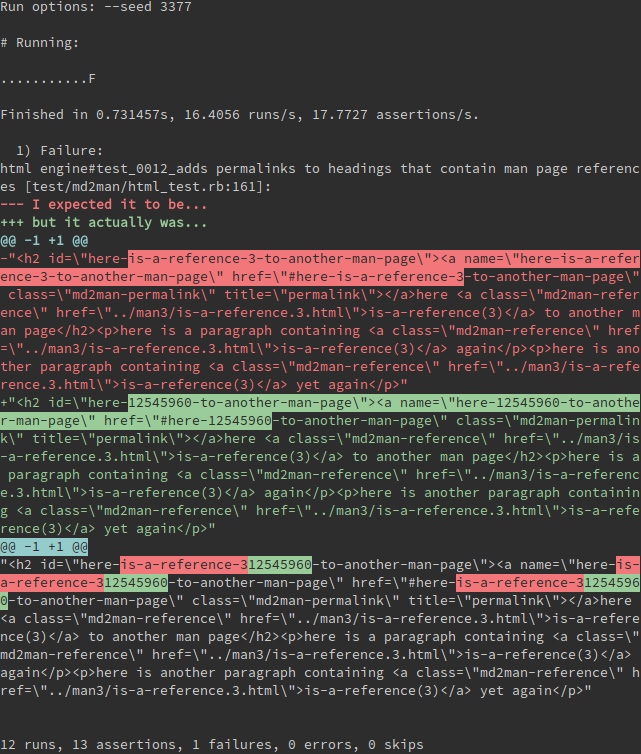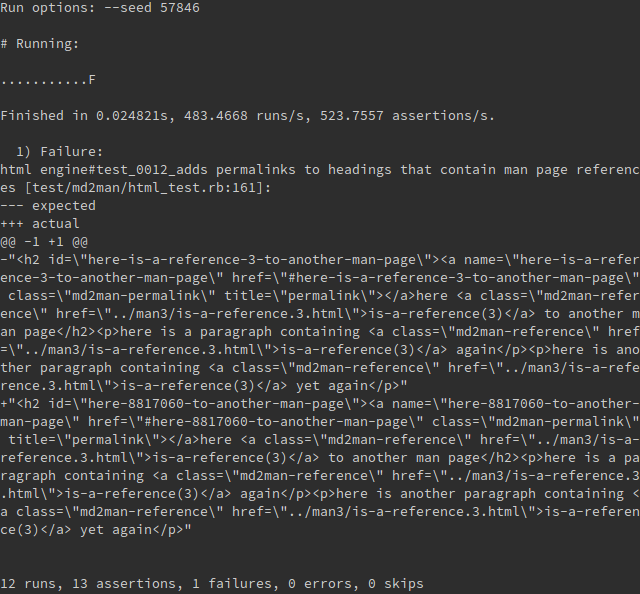Colorful assertion failure diffs in MiniTest

Problem
After a long day of practicing test driven development in Ruby, I grew
weary of mentally parsing the colorless diffs that MiniTest displays when
assert_equal fails:

Approach
I dove into the MiniTest codebase using ack, hoping to find some way to pipe its diff output into colordiff during display, and discovered that MiniTest already shells out to diff(1) to produce its diff output.
In fact, MiniTest tries several different flavors of diff(1) before falling back to the standard one. One of these flavors is the
mysterious gdiff, which neither exists on my Arch Linux system nor is
available in its package repositories. That’s the ticket!
Solution
I quickly masqueraded colordiff as gdiff within my user account:
ln -s `which colordiff` ~/bin/gdiff
re-ran my failing test, and saw colored diffs in the failure report!
~/bin/gdiff
Three years later, in the summer of 2014, I wrote my own gdiff script in
Ruby to further enhance the readability of MiniTest’s assert_equal diffs
by intelligently combining two complementary approaches of visualizing
intra-line differences into a single format:

There are several things happening in the screenshot above:
The changes are first visualized as a line-wise diff using the
diff-highlightscript (if available) that comes bundled with Git itself.A redundant hunk header (in this case: @@ -1 +1 @@) is displayed in reverse video to indicate where the first visualization ends and where the second begins.
The changes are visualized again as a character-wise diff by squashing common portions of changed lines using Git’s native
--word-diff-regexalgorithm unless the hunk being visualized only consists of whitespace changes.
As you can see, the second visualization complements the first by showing you the character-wise differences within the line-wise differences! This combination provides a more meaningful difference visualization overall.
In addition, this gdiff(1) script goes beyond standard diff(1) to:
- color-code file headers according to difference highlighting colors
- provide human-friendly descriptions of MiniTest value assertions
- use blue instead of green for users who indicate that they are
colorblind by setting the
$COLORBLINDenvironment variable
Finally, here is the source code of my gdiff(1) script, also available on
GitHub, ready for
use. Simply download it into your ~/bin directory and happy diffing! :)
#!/usr/bin/env ruby
#
# MiniTest runs this command to show the differences between expected and
# actual values in assert_equal(), so we make it word-aware and colorful.
#
# You can make this script use blue instead of green by setting the COLORBLIND
# environment variable, as described at https://pypi.python.org/pypi/fragments
#
# See http://sunaku.github.io/minitest-colordiff.html for more information.
#
require 'shellwords'
FILE_BEGIN_REGEXP = /\A\e\[1mdiff/
HUNK_BEGIN_REGEXP = /(?=^\e\[36m@@)/
# highlight the different inside changed lines while keeping unified output
linewise_diff = `git diff --color=always #{ARGV.shelljoin} |
( perl /usr/share/doc/git/contrib/diff-highlight/diff-highlight || cat )`
linewise_hunks = linewise_diff.split(HUNK_BEGIN_REGEXP)
# squash common portions of changed lines and only highlight the differences
# http://neurotap.blogspot.com/2012/04/character-level-diff-in-git-gui.html
charwise_diff = `git diff --color=always --color-words \
--word-diff-regex='[^[:space:]]|([[:alnum:]]|UTF_8_GUARD)+' #{ARGV.shelljoin}`
charwise_hunks = charwise_diff.split(HUNK_BEGIN_REGEXP).map do |hunk|
# nullify character-wise diffs that don't give any whitespace information
if hunk =~ /\S\e\[3[12]m.*?\e\[m/
# highlight headers to indicate that these character-wise diffs are
# alternate representations of the line-wise diffs that precede them
# and also highlight the changes themselves in character-wise diffs
hunk.gsub(/\A\e\[36(?=m@@)|\e\[3[12](?=m.*?\e\[m)/, '\&;7')
end
end
# combine the diffs by joining the charwise output into the linewise output
# and use uniq() to show only one copy of common hunks between both outputs
diff = linewise_hunks.zip(charwise_hunks).map(&:uniq).flatten.map do |hunk|
if hunk =~ FILE_BEGIN_REGEXP
# strip diff headers and git index headers which mention /tmp/* files
hunk.sub(/\A.+\bexpect.+\bbutwas.+\n\e\[1mindex.+\n/, '').
# provide human-friendly descriptions of MiniTest value assertions
sub(/(?<=m-{3}\s)\S+?\bexpect\S+/, 'I expected it to be...').
sub(/(?<=m\+{3}\s)\S+?\bbutwas\S+/, 'but it actually was...').
# color-code file headers according to difference highlighting colors
sub(/^\e\[1(?=m-{3})/, '\&;31').sub(/^\e\[1(?=m\+{3})/, '\&;32')
else
hunk
end
end.join
# use blue instead of green for users who indicate that they are colorblind
diff = diff.gsub(/(\e\[[\w;]*\b3)2m/, '\14m') if ENV['COLORBLIND']
print diff
Ruby on Rails integration
Installing the above gdiff script is not enough for Ruby on Rails (which provides its own, plain “expected but was” message for assertion failures) so the following monkeypatch is necessary in your test helper to override Ruby on Rails’ assertion failure messages with MiniTest’s native diffing.
class Minitest::Unit
alias _0dcfe0e3_de10_40df_bc94_da27aa85c215 puke
def puke klass, meth, e
if e.message =~ /\\A<(.*?)> expected but was\\n<(.*?)>\\.\\Z/m
e.message.replace Object.new.extend(Minitest::Assertions).diff($1, $2)
end
_0dcfe0e3_de10_40df_bc94_da27aa85c215 klass, meth, e
end
end
After adding the above snippet to your test/test_helper.rb file, you
should now see the forementioned gdiff script being used in Ruby on Rails!